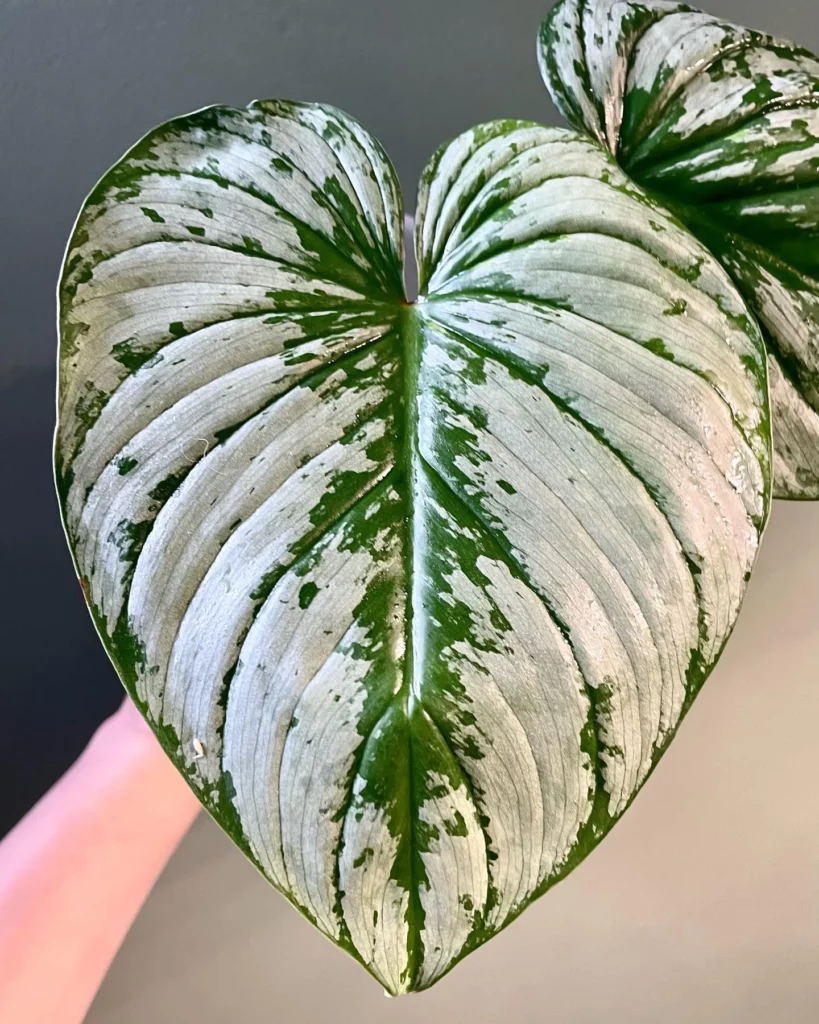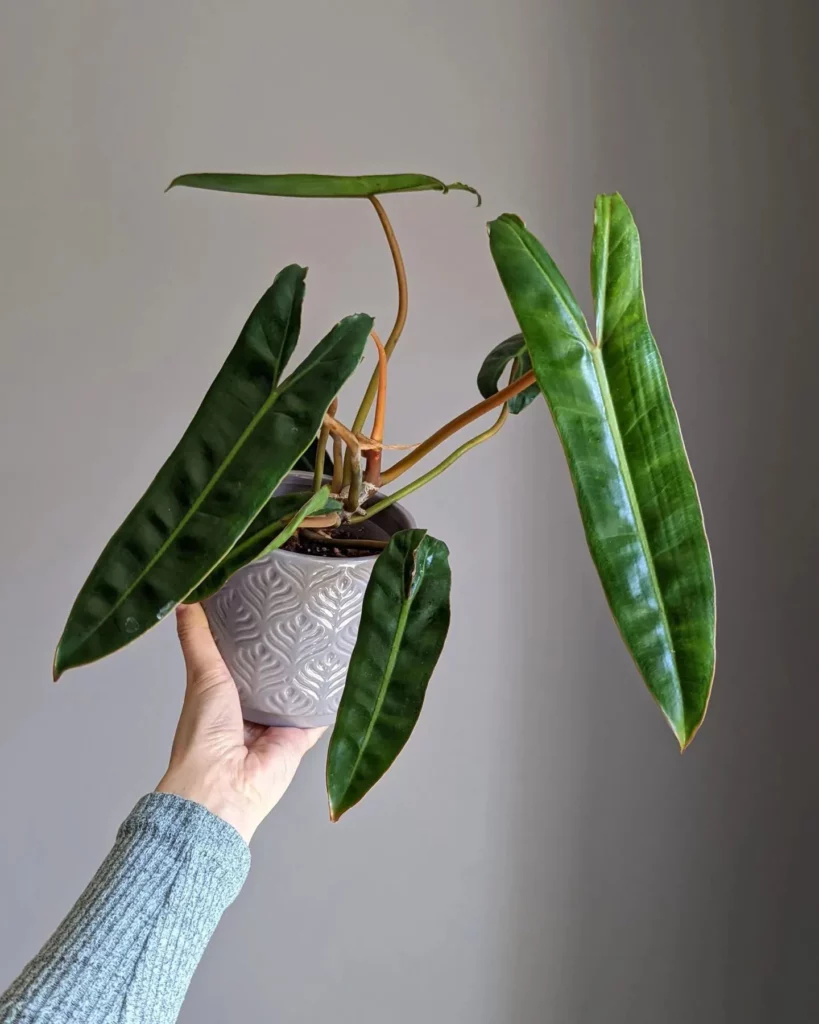The Philodendron Prince Of Orange is a stunning houseplant with vibrant and glossy leaves. Its heart-shaped foliage starts off a bright orange color, slowly transitioning to a deep green as the leaves mature. Its compact growth habit makes it an eye-catching addition to any indoor space. With its unique appearance, the Philodendron Prince Of Orange is sure to impress anyone who sets eyes on it.
Other Interesting Philodendron Plants: Philodendron Pink Princess & Philodendron White Princess
Appearance of the Philodendron Prince Of Orange

Light Requirements for the Philodendron Prince Of Orange
Philodendron Prince Of Orange needs bright but indirect light. Place it in an area where it can receive moderate to high levels of light, making sure to avoid direct sunlight which may scorch the leaves.
A good spot near a window with filtered light or a few feet away from a well-lit area is ideal. Make sure to adjust the location according to the season and the changes in light intensity.
Keeping your plant in the right lighting conditions is crucial for its overall health and well-being, and it will reward you with glossy and vibrant foliage.
Watering the Philodendron Prince Of Orange



Philodendron Prince Of Orange requires moist soil, but overwatering can lead to root rot and other complications. To maintain a healthy watering routine, you should allow the top inch of the soil to dry out before watering your plant. This will allow the roots to breathe and prevent excess moisture from building up in the soil.
Be sure to thoroughly saturate the soil with water until it drains out of the bottom of the pot. This will ensure that the roots are receiving enough moisture to thrive. Regularly check the soil moisture levels to develop a consistent watering schedule that suits your plant’s needs.
Fertilizing the Philodendron Prince Of Orange
If you want your Philodendron Prince Of Orange to thrive and flaunt healthy growth and vibrant foliage, fertilization is key. During the growing season (spring and summer), you should fertilize your plant every two to four weeks. Choose a balanced liquid fertilizer and dilute it according to the package instructions. Overfertilizing can cause mineral buildup and harm the roots, so make sure to avoid doing so.
No products found.
Potting the Philodendron Prince Of Orange
If you want your Philodendron Prince Of Orange to grow happily, it’s essential to repot when it needs more room.
Choose a pot that is slightly larger than the current one, with a drainage hole. Also, pick a well-draining soil mix that consists of perlite, peat moss, or coconut coir to allow proper drainage.
No products found.
Gently remove your Philodendron Prince Of Orange from its old pot, loosen the roots, and carefully place it in the new pot. Fill in with fresh soil mix, ensuring the plant is at the same depth as before.
After repotting, water the plant thoroughly and ensure it receives enough bright, indirect sunlight.
Propagation of Philodendron Prince Of Orange

Propagation through stem cuttings is a fantastic way to propogate Philodendron Prince Of Orange.
First, select a healthy stem with at least two nodes and remove the lower leaves from the stem.
Next, place the cutting in a container with either water or a well-draining soil mix, ensuring that the node(s) are submerged or covered. Keep it in a warm and humid environment until roots develop.
Once the roots have sufficiently grown, it is time to transfer your beautiful new plant to a pot with potting soil. Continue to care for it as you would any other adult plant in your collection.
Growth and Development of the Philodendron Prince Of Orange
The Philodendron Prince Of Orange is a moderate grower and can reach a height of 2 to 3 feet when fully mature. With proper care and conditions, your plant will add new leaves regularly, contributing to its overall beauty and lushness. Pruning can help keep it compact and encourage bushier growth.
Managing Pests and Diseases for the Philodendron Prince Of Orange
Despite being generally resistant, the Philodendron Prince Of Orange can still be prone to pesky pests and diseases. Keep an eye out for common indoor plant issues like aphids, mealybugs, and spider mites. Don’t hesitate to perform regular inspections and carefully examine the foliage for signs of damage, discoloration, or unusual spots.
If you do come across any pests or suspect a potential disease, it’s important to take quick and appropriate action to mitigate the issue. Depending on the situation, you can potentially use natural remedies, such as spraying the leaves with a mild soap solution or wiping them down with a gentle cloth. There are also a variety of chemical treatments available at your local garden store if needed.
Other Care Tips for the Philodendron Prince Of Orange
Now that you know the basics of caring for your Philodendron Prince Of Orange, there are a few additional tips to keep in mind. Firstly, make sure to wipe the leaves occasionally with a damp cloth to remove any dust and debris. This will help the plant receive maximum sunlight and stay healthy.
- Maintain adequate humidity levels by placing a humidifier near the plant or misting the leaves with water. This is especially important in dry environments or during the winter months when indoor heating can reduce humidity levels.
- Avoid placing your Philodendron Prince Of Orange in areas that experience extreme temperature fluctuations, such as near windows or air conditioning vents. Drafts and sudden changes in temperature can stress the plant and hinder its growth.
Conclusion
Always be on the lookout for pests and diseases and take immediate action if you notice anything unusual. Clean the leaves, maintain humidity levels, and avoid exposing your plant to extreme temperatures or drafts.
You have the power to create a thriving indoor garden, and the Philodendron Prince Of Orange is a beautiful addition to any collection. Good luck on your plant journey!
FAQ
What is the appearance of the Philodendron Prince Of Orange?
The Philodendron Prince Of Orange is a stunning houseplant known for its vibrant and glossy leaves. The leaves start off a bright orange color, slowly transitioning to a deep green as they mature. Its heart-shaped foliage and compact growth habit make it an eye-catching addition to any indoor space.
What are the light requirements for the Philodendron Prince Of Orange?
Philodendron Prince Of Orange thrives in bright, indirect light. It should be placed in a location where it can receive moderate to high levels of light. Avoid direct sunlight as it can scorch the leaves. A good spot near a window with filtered light or a few feet away from a well-lit area is ideal.
How should I water the Philodendron Prince Of Orange?
Proper watering is crucial for the health of your Philodendron Prince Of Orange. Allow the top inch of the soil to dry out before watering, and then thoroughly saturate the soil until water drains out of the bottom of the pot. Be careful not to overwater, as this can lead to root rot. Regularly check the moisture level of the soil to establish a watering schedule that suits your plant’s needs.
How often should I fertilize the Philodendron Prince Of Orange?
To promote healthy growth and vibrant foliage, fertilize your Philodendron Prince Of Orange every two to four weeks during the growing season (spring and summer). Use a balanced liquid fertilizer diluted according to the package instructions. Avoid overfertilizing as it can cause mineral buildup and damage the roots.
How do I pot the Philodendron Prince Of Orange?
As your Philodendron Prince Of Orange grows, it may require repotting to provide enough space for its expanding root system. Choose a well-draining potting mix and a container that is slightly larger than the current one. Gently remove the plant from its old pot, loosen the roots, and place it in the new pot. Fill the remaining space with fresh potting mix, ensuring that the plant is at the same depth as before.
How can I propagate the Philodendron Prince Of Orange?
You can propagate Philodendron Prince Of Orange through stem cuttings. Select a healthy stem with at least two nodes and remove any lower leaves. Place the cutting in water or a well-draining soil mix, ensuring that the node(s) are submerged or covered. Keep the cutting in a warm and humid environment until roots develop. Once rooted, transfer the new plant to a pot with potting soil and care for it as you would an adult plant.
How does the Philodendron Prince Of Orange grow and develop?
The Philodendron Prince Of Orange has a moderate growth rate and can reach a height of around 2 to 3 feet when fully mature. With appropriate care and conditions, you can expect new leaves to emerge regularly, adding to the plant’s overall beauty and lushness. Pruning can help maintain a compact shape and encourage bushier growth.
How can I manage pests and diseases for the Philodendron Prince Of Orange?
While the Philodendron Prince Of Orange is generally resistant to pests and diseases, it can still encounter common indoor plant issues. Keep an eye out for pests like aphids, mealybugs, and spider mites. Regularly inspect your plant for any signs of damage, discoloration, or unusual spots on the foliage. If you notice any pests or suspect a disease, promptly take appropriate measures such as using natural or chemical treatments to mitigate the problem.
Do you have any additional care tips for the Philodendron Prince Of Orange?
Besides regular care considerations, it’s important to clean the leaves of your Philodendron Prince Of Orange occasionally to remove dust and promote better photosynthesis. Additionally, ensure adequate humidity levels by misting the leaves or placing a humidifier nearby, especially in drier environments. Avoid exposing your plant to extreme temperatures, drafts, or sudden changes in temperature.








